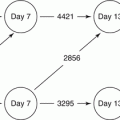Fig. 1.1
Penile spines of the glans penis of rats stimulate the vagina of the female during mating to extend CL lifespan beyond a normal 4-day estrous cycle. If maternal recognition of pregnancy is considered extending CL function beyond the estrous cycle, the penile spines could be considered one of the earliest signaling mechanisms evoked even before fertilization. However, establishment of a pregnancy by viable blastocysts/conceptuses involves a more elaborate interaction between the maternal endometrium and implanting conceptus. Note that the short estrous cycle, mating-induced CL extension, and the ability to induce embryonic diapause place mice and rats among the more efficient and prolific species of mammals for reproduction
Over the past few decades, technological advances in transcriptomics, proteomics, metabolomics, and glycomics along with the ability to selectively knockout genes of interest has greatly advanced our understanding of maternal-conceptus interactions that are essential for the establishment and maintenance of a successful pregnancy. This knowledge provides a foundation from which to build research endeavors to help resolve infertility, embryonic loss, and recurrent abortion in humans, captive wild animals, and important farm species. The present volume on “Regulation of Implantation and Establishment of Pregnancy in Mammals” brings together current reviews from leading experts to address the diversity of mechanisms by which species establish and maintain pregnancy. Implantation in mice, dogs, pigs, cattle, sheep, horses, primates, humans, and species in which embryonic diapause occurs are discussed. Reviews will provide current knowledge on the role of endometrial steroid receptors, adhesion factors, cytokines, interferons, steroids, prostaglandins, growth factors, and immune cells involved with regulation of conceptus development. This knowledge provides a foundation for the development of strategies to resolve infertility, embryonic loss, and recurrent abortion in humans, captive wild animals, and important farm animal species in the future.
Stay updated, free articles. Join our Telegram channel

Full access? Get Clinical Tree







